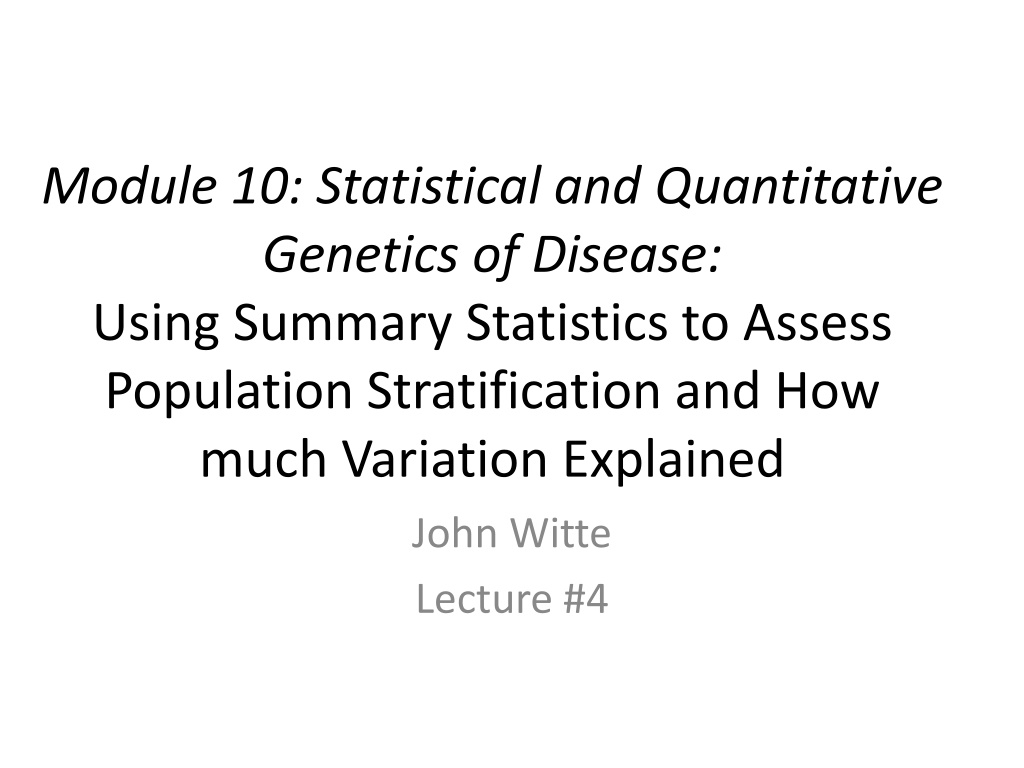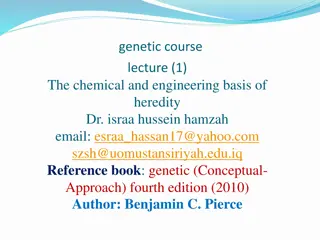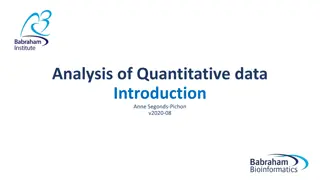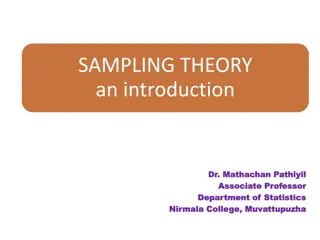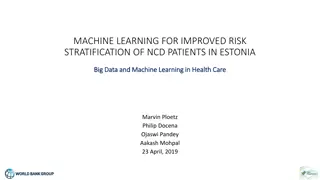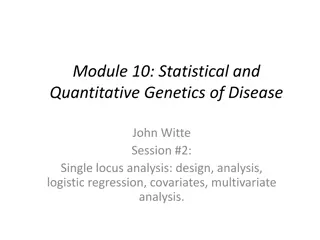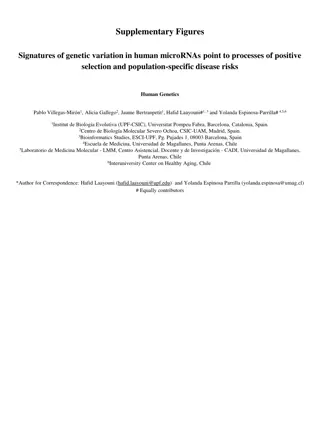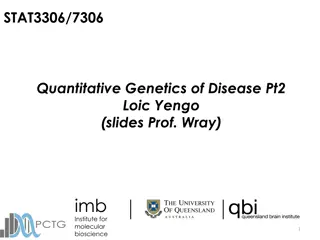Statistical and Quantitative Genetics of Disease: Understanding Population Stratification
This lecture explores the use of summary statistics to assess population stratification and the impact of LD on association studies in statistical and quantitative genetics. It delves into LD scores, genomic inflation, polygenic inheritance, and separating SNP heritability from population stratification. The discussion emphasizes the importance of considering LD among SNPs, expected values of summary statistics, and differentiating between polygenicity and population stratification in GWAS.
Download Presentation

Please find below an Image/Link to download the presentation.
The content on the website is provided AS IS for your information and personal use only. It may not be sold, licensed, or shared on other websites without obtaining consent from the author. Download presentation by click this link. If you encounter any issues during the download, it is possible that the publisher has removed the file from their server.
E N D
Presentation Transcript
Module 10: Statistical and Quantitative Genetics of Disease: Using Summary Statistics to Assess Population Stratification and How much Variation Explained John Witte Lecture #4
LD Score: Distribution of Associated SNPs QQ-Plot If a proportion of SNPs associated: observed = expected (median test statistic) Observed -log10(p) If observed > expected: genomic inflation Due to population stratification? Expected -log10(p) Yang et al (2011). EJHG
Genomic Inflation Expected under Polygenic Inheritance Under null hypothesis: Mean test statistic ( mean) = median test statistic ( median) Under polygenic inheritance (no population stratification): mean > median mean reflects SNP heritability hg2 median reflects # causal variants contributing to hg2 Controlling for genomic inflation may remove both pop strat and real effects. How to tell them apart? Yang et al (2011). EJHG
Impact of LD on Association LD among SNPs: Consider causal SNPs All in LD with causal SNP also associated Lonely SNPs only associated if causal More tagging of SNPs, more likely to tag a causal variant. If all SNPs equally likely associated given LD status, expect more association for SNPs with more LD friends . This is a reasonable assumption under a polygenic genetic architecture. Slide: Ben Neale
Expected Value of Summary Stats Sample size SNP heritability LD Score of SNP j: amount of genetic variation tagged by j. Number of SNPs LD Score: r2 LD between SNP j and neighboring SNPS But can t separate out population stratification here. Bulik-Sullivan, et al. NG 2015
Expected Value of Summary Stats Separating hg2 and population stratification Population Stratification factor Same as before intercept slope regression Bulik-Sullivan, et al. NG 2015
Polygenicity vs Population Stratification Stratification Polygenicity GWAS QQ Plot Regression of association X2 statistic on LD score Bulik-Sullivan, et al. NG 2015
Measures of Variation Explained Assume we ve identified risk variants from single locus models. Once discovered, what next? Search for more risk variants? Focus on their biology? Probably both! Depends on their overall impact on disease. Can assess with a number of measures give values between 0 and 100%
Measures to Assess Impact Heritability explained Sibling recurrence risk explained Log RR: familial risk explained Area under the receiver-operating curve (AUC) Population attributable fraction (PAF) Key questions: How do these measures compare? Do they provide similar info? Does genetic architecture of disease impact differences?
Different Messages? Results in contrasting and confusing use of these measures. Example, for Crohn s disease variants in NOD2 reported to explain: 1-2% of heritability ~5% of familial risk 18% of the PAF
Heritability Explained Heritability: h2L[i]= VAL[i] / VPL[i] =VAL[i] / (VGL[i] + 1) where V*L[i] = additive (*=A), phenotype (*=P), genetic (*=G) variance. VA = (1-p)24p2 2 + 2p(1-p)((1-p)-p)2 2 + p24(1-p)2 2 = 2p(1-p) 2 = a+d((1-p)-p) (ave effect of replacing a b allele by a B allele). VD = (1-p)24p4d2 + 2p(1-p)4p2(1-p)2d2 + p24(1-p)4d2 = (2p(1-p)d)2 VG = VA + VD (Applied to liability risk genotypic values.) Heritability explained: h2L[i] / h2L i Across multiple variants: h2L[i] / h2L (Falconer & Mackay 1996)
Heritability Approximation If we can assume small RR and a multiplicative model (RRBb2 = RRBB). Then, h2Lapprox[ i] = 2p(1-p)(RRBb-1)2/x2 where threshold T that truncates the proportion K, T= -1(1-K) x = the mean liability of cases, approximated as z/K z is the height of the standard normal distribution at the Heritability explained: h2Lapprox[i] / h2L Stahl et al., Nat Genet 2012
Sibling Recurrence Risk Explained Proportion of the total sibling risk explained by the risk variants (observed scale). Siblings share VAO/2 + VDO/4 of risk. VAO[i] = k2bb2*p(1-p)(p*(RRBB-RRBb)+(1-p)*(RRBb-1))2 VDO[i] = k2bbp2(1-p)2(RRBB+1-2*RRBb)2 Sibling risk explained: log( S[i]) / log( S) Across multiple variants:
Log RR: Familial Risk Explained More epidemiologic approach. Genetic variance attributable to the ith locus on the log risk scale: where M is the mean value of log relative risk, M= 2p(1-p) log(RRBb) + p2 log(RRBB). Multiple alleles, log-risk ~N with var=2log( S) Variation explained: VGlog[i]/ 2log( S) Across multiple variants VGlog[i]/ 2log( S) i Pharoah et al., Nat Genet 2002
Area Under the Curve where x = mean liability among cases v = -x * K(1-K) T= population threshold (determined from the disease prevalence K) Proportion explained: divide risk variant AUC by the maximum attainable AUC for a genetic risk predictor. [(AUCL[i]-0.5) / (AUCMax-0.5)]2 Wray et al., Plos Genet 2010
Application Explore how these measures can imply different impacts of genetic variants on disease. Calculate them across studies of: a) Breast cancer b) Crohn s disease c) Rheumatoid arthritis d) Schizophrenia
Results: Breast Cancer a) Breast Cancer 16 9 Percentage 4 1 M=65 K=0.12 SRR=2 h2=0.6 0 Heritability (17.7%*) Approx. Herit. (12.6%) Sibling RR (22.4%) Family RR (20.8%) AUC (19.0%) Measure RR 1.3 1.3 < RR 2 2 < RR 15 RR>15
Results: Crohns Disease b) Crohn's Disease 16 9 rs5743293 RR=3.1, RAF=0.02 Percentage 4 rs1120902 RR=2.4, RAF=0.93 1 M=165 K=0.005 SRR=10.3 h2=0.72 0 Heritability (16.4%*) Approx. Herit. (17.8%) Sibling RR (24.7%) Family RR (21.2%) AUC (33.8%) Measure RR 1.3 1.3 < RR 2 2 < RR 15 RR>15
c) Rheumatoid Arthritis Results: RA rs6910071, HLA-DRB1E RR=2.88, RAF=0.22 16 9 Percentage 4 1 M=36 K=.01, SRR=6 h2=0.63 0 Heritability (14.8%*) Approx. Herit. (20.0%) Sibling RR (25.3%) Family RR (18.6%) AUC (24.3%) Measure RR 1.3 1.3 < RR 2 2 < RR 15 RR>15
Results: Schizophrenia d) Schizophrenia 16 CNVs: 16p11.2, 22q1 RR>25, RAF=0.0003 9 Percentage 4 1 M=24 K=.01, SRR=8.8 h2=0.8 0 Heritability (2.5%*) Approx. Herit. (15.9%) Sibling RR (24.3%) Family RR (2.9%) AUC (4.9%) Measure RR 1.3 1.3 < RR 2 2 < RR 15 RR>15
What goes into Denominator? All measures considered here require specification of a denominator. The apparent impact of genetic variants can hinge on the baseline or overall risks. Undertake probabilistic sensitivity analyses to explore how results vary across risks. Final results in terms of benchmarking, not exact estimates.
Population Attributable Fraction Proportion by which disease reduced in a population if exposure to a risk factor(s) was reduced or removed. For multiple variants:
Population Attributable Fraction ~ Order of magnitude larger than other measures. As RAF > 0.50, PAF only measure that increases. When RR and RAF get large, single variant PAF approaches 100%. Examples: Breast cancer variant (rs10771399, RR=1.2, RAF = 0.90) PAF=28% Schizophrenia rare variant (CNV at 16p11.2, RR=26, RAF = 0.0003) PAF =1.4% Combined PAF > 90% (=100% with Crohn s variants)
Computational Anomaly in PAF Apparent impact of each additional risk variant depends on which variants have already been incorporated. E.g., assume two genetic variants for a disease: each with individual PAF=0.50 combined PAF = 0.75 (=1-(1-0.5)2). Remove 1 variant disease by . Remove 2nd disease by in remaining popln. Or by in original population.
PAF curve Depends on SNP Order 1 0.9 0.8 0.7 0.6 Joint PAF 0.5 0.4 0.3 0.2 0.1 0 1 11 21 31 41 51 61 Number of Breast Cancer Risk Variants Largest to Smallest PAR Smallest to Largest PAR Largest to Smallest RR Smallest to Largest RR
Another Issue with PAF Combined PAF not analogous to that obtained by removing an environmental exposure (smoking). As the number of known risk loci continues to increase, essentially everyone in the population will carry a number of risk alleles. Then any preventative treatment directed at countering the risk loci would have to be applied to the entire population, which seems very unrealistic.
Take Home For common and rare variants of varying penetrance, use heritability explained or the proportion of genetic risk on a log-scale. Avoid approximation to the heritability and sibling relative risk because they break down for rare, high-penetrance variants (vastly inflated estimates). Issues with AUC, and PAF has a number of undesirable properties.
